- Administrator
- Albums and Singles
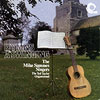 In Trunk's catalog are many bizarre treats. The label has issued obscure soundtracks, musique concrète by an ex-Spitfire pilot, poetic porn, tunes from forgotten children's TV shows and much more. Now comes their very first CD release of easy listening sunshine pop adaptations of Church of England hymns, which has long enjoyed a cultish following and bootlegged life since its original 1960s release. These swinging arrangements of traditional melodies are amusing, perplexing creations; they are by turns delighful and repulsive.
In Trunk's catalog are many bizarre treats. The label has issued obscure soundtracks, musique concrète by an ex-Spitfire pilot, poetic porn, tunes from forgotten children's TV shows and much more. Now comes their very first CD release of easy listening sunshine pop adaptations of Church of England hymns, which has long enjoyed a cultish following and bootlegged life since its original 1960s release. These swinging arrangements of traditional melodies are amusing, perplexing creations; they are by turns delighful and repulsive.
Originally issued on Davjon Records (a small label with negligible distribution), the rarity of Hymns A Swinging is a major reason for its legendary status. Trunk has previously issued a couple of tracks from this album on the sampler Resurrection: The Amplified Bible of Heavenly Grooves, but hearing the entire album is an unmissable experience.
The image provided of The Mike Sammes Singers is a magnificent depiction of buttoned-up bygone glamor and total repression. The men that make up the band have greased back short-back-and-sides haircuts, neckties peeping from under V-necked sweaters, and ample trousers revealing nothing. The women wear tight-waisted floral frocks and their hair is barely softer than Vera Lynn's stiff wartime hairdo. The voices of the group are precise and playful yet pure. They're very adept with advertising jingles, some of which can be heard on their album Music For Biscuits, also reissued by Trunk. Their "Timex" jingle is a personal favorite.
Hymns A'Swinging opens with The Ted Tayor Organsound laying down a chunky groove that might have been dropped off a British version of a Blacksploitation flick. When the singers enter, though, the mood of the song is abruptly altered; I laughed and almost snorted the bone out of my nose once they began. Indeed, anyone catching a glimpse of me stuck in traffic listening to the remainder of that track, "Harvest Home," and the next couple ("Hills of The North" and "40 Days and 40 Nights") might have been concerned that I had slipped into a waking coma, was researching mouth-breathing techniques, or accidentally revisiting a horrible nightmare. After a few listens I've been able to revisit the record and appreciate it for more than the humor it provides. Now Irelish the bongo fury and jazz flute on "All Things Bright And Beautiful" which also includes tight echoey guitar in the style of "Summer Holiday" and jabbering soprano scat and syrupy tenor voices. It wouldn't surprise me, however, if someone were to mistake parts of the album for a dull children's record gone horribly wrong.
There are sublime moments amidst the ridiculous ones, however. The breaks on "Immortal Invisible God Only Wise" are truly unbelievable and Len Clarke's spritely crisp drumming won me over very quickly. It's worth noting that the Ted Taylor Organsound also features the talents of jazz legend Tubby Hayes on tenor sax and flute. Ike Issacs, Clive Hicks, and Cedric West take turns on the guitar and Mike Nottingham's bass parts also fit the bill. Mercifully, Ted Taylor doesn't ram his organ into every available space, for which we might all be grateful.
I would even claim that the jumble of styles found on this record form a match made in heaven... or a match made in the mixed-up, post-war world of England. The charm of the Church of Engand—despite its origins in Henry VIII's land and power grab—is that it may often be considered the least dogmatic of all organized religions. In my experience most Church of England vicars would sooner discuss jam and gardening than Jesus and God. Many might react with mild surprise to the idea that some people believe in a literal seven day creation story, miracles, and resurrection. Maybe it's a healthy aversion to talking about work or perhaps a modest caution, but those vicars seem less at ease with life after death than with tea and cake. Culturally disinclined to consider, say, abortion or sexuality, their moral reasoning is usually preserved for such topics as Test Match cricket and town planning. When pressed, one such dog-collared fellow once mentioned to me that perhaps we humans are like tadpoles, with the opportunity to one day become...well... frogs. An enduring image, of sorts.
The real merit of Hymns A' Swinging is that the whole project has a charming light touch which transforms these hymns from the Church of England songbook. It's as if they might have been born to submit to the arrangements of a music director like David Moses. An element of shock is also present: when listening to any of the intros to these tracks it's impossible to guess what the song will be. As with all Trunk releases, my advice is to throw caution to the wind, believe in your ears, and let yourself be transported to a different place. An alternate title for this, arguably the most outrageous Trunk release yet, might be Music For Tadpoles, then.
samples:
Read More
- Administrator
- Albums and Singles
 Heavily sourced from both field recordings and guitar, the material on this disc gives the natural color of its geographic location: an ammunitions bunker and its surrounding wilderness the spotlight. As a whole the pieces are staunchly minimalist, allowing the core sounds to be the focus rather than a great deal of electronics or processing, which is surely artist Cameron Webb’s intent with this work.
Heavily sourced from both field recordings and guitar, the material on this disc gives the natural color of its geographic location: an ammunitions bunker and its surrounding wilderness the spotlight. As a whole the pieces are staunchly minimalist, allowing the core sounds to be the focus rather than a great deal of electronics or processing, which is surely artist Cameron Webb’s intent with this work.
The most literal interpretations of the theme that can be heard here are the two "Inside" tracks (both sequenced towards the early part of the disc), and the closing "Outside." The former two are brief, but are slow motion studies of reverb, all leaning on the dark and obfuscated elements of that effect. Given it was recording in a massive decommissioned bunker, it is entirely likely that the reverb is more the product of actual environment instead of traditional VST plugins. The converse is the album closer, "Outside," which is exactly that: a lush field recording of rain enveloping the mix, with some far off bird calls to signify the light outside of the massive, cold structure.
The pieces in between these two take different directions, but continue to use similar themes throughout. With the exception of its first part, the six pieces of "Ammunition" focuses mostly on the clear sounds of untreated guitar. The plaintive, looped guitar notes are the focus, with the occasional piece of glitch texture or electronic pulse to show up, but almost always remaining extremely subtle, to leave the focus on the organic guitar. The "Ammunition" suite does, however, open with a passage of humming and buzzing, with melodic beeps, while it closes with static, frigid tones, a small amount of static, and the birds chirping in the distance.
The three-piece "Installation" suite emphasizes the digital sounds more, but still with Webb’s sense of restraint. The first part is fuzzy opaque static—not quite distortion, yet thick and dense—with swells of melody below the grimy noisier elements. The second segment continues this, allowing delicate chiming tones and other soft elements to occasionally rise to the surface above rattling electronics and ground hum distortion. The set closes with swirling guitar and bird calls, though still secondary to the synthetic and processed sounds, but never being too obscured.
The recording location for these tracks could undoubtedly be said to have influenced the sound, because the disc is a perfect sonic metaphor for an empty ammunitions bunker within a delicate ecosystem and nature preserve. With extreme restraint digital instrumentation, traditional guitar, and field recordings are allowed to coexist, and I don’t think it is an accident that the most memorable sounds are the natural ones when all is said and done.
samples:
Read More
- Administrator
- Albums and Singles
 While he first made a name for himself with the balls out psych rock of Loop, Robert Hampson always had an inclination towards the esoteric and avant garde. The slide away from rock into musique concrèt for him is pretty obvious to anyone familiar with his Main project, which began as a krautrock inspired industrial band and ended with the pure sonic abstraction that has segued into this new solo work. Rather than working with guitar (as Loop and Main were based upon), these works, two of which were commissioned by GRM, instead allow for a wider sonic palate to be used, and the results are captivating.
While he first made a name for himself with the balls out psych rock of Loop, Robert Hampson always had an inclination towards the esoteric and avant garde. The slide away from rock into musique concrèt for him is pretty obvious to anyone familiar with his Main project, which began as a krautrock inspired industrial band and ended with the pure sonic abstraction that has segued into this new solo work. Rather than working with guitar (as Loop and Main were based upon), these works, two of which were commissioned by GRM, instead allow for a wider sonic palate to be used, and the results are captivating.
"Umbra" originates from a 16 track piece from 2006, and is not a drastic departure in sound for any who followed Hampson’s trek as Main: it retains his fondness for vast soundscapes of alien insectoid chattering, here met with a low frequency bass rumble and occasional fragments of pure tones. While it stays consistent with mood and feel, the dynamics of the track change frequently: once a set of textures have been allowed to develop, they’ll be abruptly cut-off and then replaced with a new set to rebuild from scratch. The source of the sounds is anything but clear, but found sound percussion, objects and metal objects vibrating, and the occasional loud crash or sharp crack are recurrent motifs throughout.
Hampson’s work here is both figuratively and literally linked to astronomy, which has been one of his passions since the early days in Main (I know as a teenager listening to those releases, I had to do some searching to figure out what those track titles were all about). Rather than merely conjuring images of the universe by the titles, the tracks on Vectors actually use this as a source of the sound. The middle piece, "Ahead-Only the Stars," is dedicated to the astronauts of the Mercury space program, as well as pilot Chuck Yeager. The opening clearly showcases the flight of jets across the sky, which later becomes the underlying sonic element buried under layers of effects and processing, becoming a looped, almost rhythmic passage of noise. On top of this are bits of static and radio transmission beeps, all with any actual voices removed. The departure of the human element from this technology gives a much different sensation than if it had been left in, and the fragments around the communications make for interesting sounds all their own.
The final piece, "Dans Le Lointain," takes the space concepts in a different direction, and is constructed from cassettes recorded of shortwave radio transmissions from the early 1980s. These tapes were then treated with traditional tape manipulation, as well as digital effects, and the result is a sprawling, 20 minute track of high pitched chimes and static loops. The mix as a whole emphasizes the treble and melds metallic rattles and percussive shaking with found noises and static loops, with the occasional soft melodic pulse, giving some sense of traditional "music" within the space. The closing textural static is some of the best I’ve heard on record, with a crunch that is almost tactile.
This first "true" solo album by Robert Hampson does not really stray far from what anyone would expect who is familiar with the later works of Main, but does show Hampson pushing his sonic vehicle even farther into the dark regions of space. The combination of early tape music, modern digital experimentation, and even a subtle smattering of his "rock" background makes for a sonic excursion that is among the most engaging works of electro-acoustic music I have heard this year.
samples:
Read More
- Administrator
- Albums and Singles
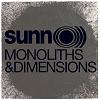 Some album titles are more apt than others but this is one album whose name rings true. With the heart stopping slabs of guitar paired with some serious musical exploration, Greg Anderson and Stephen O'Malley have looked beyond their usual extreme music surroundings and recruit some truly surprising collaborators for their most ambitious album to date.
Some album titles are more apt than others but this is one album whose name rings true. With the heart stopping slabs of guitar paired with some serious musical exploration, Greg Anderson and Stephen O'Malley have looked beyond their usual extreme music surroundings and recruit some truly surprising collaborators for their most ambitious album to date.
Sunn O))) have always incorporated musical styles from outside the doom metal ghetto to varying degrees of success. The White albums fused more experimental forms of sound with Anderson and O’Malley’s guitars and the duo have consulted an ever increasing cast of collaborators on their subsequent albums. In particular, Oracle and their album with Boris, Altar have widened the boundaries within which Sunn O))) operate. However, both these releases had their flaws as well as their successes but with Monoliths & Dimensions they managed to fully integrate their amp excess with influences from the worlds of jazz and contemporary composition.
Half the album follows a traditional path for Sunn O))), possibly due to their renewed interest in their riff and drone beginnings (recently having toured as a duo recreating the spirit of their first release live). The opening piece, “Aghartha,” unfolds over a colossal guitar riff as Atilla Csihar intones a legend about a subterranean kingdom. The track title is also a nod to Miles Davis, one of the several jazz references on Monoliths & Dimensions. The old school Sunn O))) riffage appears again on “Hunting & Gathering (Cydonia),” where Anderson and O’Malley nod once again to Earth with a riff that could easily have come from Dylan Carlson’s own fingers. As far as textbook Sunn O))) tracks go, these two follow all the rules and supplement them with little flourishes, details and surprising additions like piano and horns.
Even with the little additions as a portent of what is to come, the rest of the album is astonishing. With all the descriptions of choirs, orchestras and jazz that preceded Monoliths & Dimensions, I feared that this would be some sort of mess and that Sunn O))) would finally succumb totally to being a real life Spinal Tap and unleash a “Jazz Odyssey” on us. Thankfully, the end result is one of the most fascinating metal albums to grace my stereo in years. “Big Church” starts off with a haunting choir refrain that sounds like one of Giya Kancheli’s more harrowing works. The addition of Dylan Carlson on guitar transposes the piece from Kancheli’s bleak east to Morricone’s blood red west (and surprisingly, the choir part was a transcription based on one of Carlson’s guitar riffs).
The album’s biggest wow moment comes with the indescribably beautiful “Alice,” dedicated to the memory of Alice Coltrane and featuring ex-John Coltrane collaborator Julian Priester on trombone (along with Stuart Dempster and Sunn O))) regular Steve Moore). The music is particularly unusual for Sunn O))) in that it is joyous, spacious and relies mostly on not amplifying the hell out of everything. With each strum of O’Malley’s guitar, the ensemble (they are way too dignified to be called a bunch of session musicians or a band) play swelling chords, the notes ascending into space and beyond. Priester’s mournful, haunting but magnificent trombone plays out the album and there’s nary a dry eye in the house.
That Sunn O))) could pull this out of their hoods should not be a surprise considering they are magpie-like collectors of unusual collaborators but I am still reeling from the shock of Monoliths & Dimensions. To be completely gobsmacked by an artist I think I know well is a terrific feeling and Sunn O))) have gone beyond that. Everything about Monoliths & Dimensions is flawless, from the performance itself down to the visual presentation. Randall Dunn and Mell Dettmer’s production is superb; the balance between conservatory instruments and the guitars has been tweaked to perfection (instead of sounding like the guitars have been turned down, instruments like the piano instead sound like they are being played by giants). Even the sleeve seems so deliberate and in keeping with the musical vision. This is an album for people who love their music, not something that can be dropped into a playlist for easier digestion. Monoliths & Dimensions is tremendous in every way.
samples:
Read More
- Administrator
- Albums and Singles
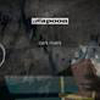 One of Robin Storey’s many strengths has been to the ability to translate the genius loci of his north England homeland into musical artifacts. Listening to Dark Rivers put me in a headspace of animistic communion with the internal and external landscapes he evokes. As the title suggests, they were mostly of an aquatic nature. These songs are fluid, amorphous, ever shifting, snaking like water from creek to river to ocean, and layered in time (spanning from monolithic rock glyphs to the military-industrial complex of the Cold War) as well as in space.
One of Robin Storey’s many strengths has been to the ability to translate the genius loci of his north England homeland into musical artifacts. Listening to Dark Rivers put me in a headspace of animistic communion with the internal and external landscapes he evokes. As the title suggests, they were mostly of an aquatic nature. These songs are fluid, amorphous, ever shifting, snaking like water from creek to river to ocean, and layered in time (spanning from monolithic rock glyphs to the military-industrial complex of the Cold War) as well as in space.
The sampled voice of Terrence Mckenna, unmistakable with its hyperspace insectoid drawl, opens the record with the time stretched utterance “something on the edge of nowhere,” announcing the liminal passages and secretive undercurrents explored on this album. Mckenna’s words encapsulate the fleeting feeling of trying to capture fugitive thoughts and images as they pass, rapid fire, through the cobwebs of the mind—the same subconscious places these songs seem to seep into and probe. Illegible voices from a police or military scanner emanate from swirling pools of reverb laden percussion, full of squelch, each one squabbling for supremacy.
“Old Gods and Freezing Rain” is a piece filled with dark echoing screams that conjure up visions of tribal warfare, sacrifice, and invocation. The rhythmic palpitations and elongated loops of “After the Storm” clear the cold air after that hiss laden aberration. The lazy pitter-patter of soft snares and brushed hi-hats is reminiscent of a slow drizzle. A few notes are played on a synth, forming concentric circles that ripple out of the stereo in a moment of transcendent beauty. Lush synth chords are also present on “The Messiah of Science,” but they are buried underneath relentless distorted rhythms. The aggression heard there is quick to abate though as “Particle Dome” mixes the calm evening chirps of crickets with detuned chanting, and a vaporous sound bringing to mind images of fog and mist rolling into the hills. The drones continue in “This Side of Zero,” the longest track at 13 minutes and sandwiched smack dab in the middle. It percolates gently with voices sounding as if they have been slurred by a tape dragging at the wrong speed. Later the crackling of a stylus emerges processed with flange or phase. “Drawing Lines in the Rocks” is another luminary song. The percussion has been sped up to the point where it does not sound like separate hits or punctuations, transforming into a smooth accelerated tone, with shimmering middle-eastern strings weaving loom like around it, at a lower volume, just beneath the surface.
Dark Rivers is filled with many of Storey’s patented techniques, his idiosyncratic use of percussion and loops, and sounds culled from various unnamed world instruments. Landscapes, whether natural or altered by man (modern or ancient) are motifs he has explored on his other albums and in his visual artwork. As such this album is a further refinement of his aesthetics and working procedures, and a represented his continued deepening immersion in the environment around him.
samples:
Read More
- Administrator
- Albums and Singles
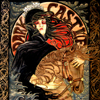 Based upon their childlike and almost self-parodyingly reductionist name and rather Dungeons and Dragons-inspired cover art, I expected Dark Castle to either be unintentionally hilarious or the most abrasive, evil, soul-withering doom metal band I have ever heard. Much to my surprise, they were neither. This male/female doom-psych duo has crafted an impressive, assured, and surprisingly melodic debut.
Based upon their childlike and almost self-parodyingly reductionist name and rather Dungeons and Dragons-inspired cover art, I expected Dark Castle to either be unintentionally hilarious or the most abrasive, evil, soul-withering doom metal band I have ever heard. Much to my surprise, they were neither. This male/female doom-psych duo has crafted an impressive, assured, and surprisingly melodic debut.
Florida's Dark Castle first appeared in 2008 with an elaborately packaged self-released demo (Flight of the Pegasus) that garned a good deal of favorable attention from the metal press and other bands (including Relapse Records' Minsk). It is easy to see why this unsigned band turned so many heads, as there are several obvious elements that separate them from their peers. For one, drummer Rob Shaffer is also the vocalist. Secondly, most of the guitar work is handled by a woman (Stevie Floyd), which is extremely rare in the extreme metal milieu. Finally, there is no bass, which is strikingly ballsy in a genre that is so intimately associated with low-frequency amplifier worship (also, they are not sludgy or dull).
"Awake In Sleep" begins the album with an extremely cool and crushing riff and thunderous, glacial drums and makes it clear that a bass player is entirely unnecessary. Dark Castle have a very pared-down and spacious sound and the songs are generally short, punchy, and skillfully constructed. While Shaffer's vocals strictly adhere to the traditional death metal growl school, the guitar work is usually melodic and hook-y enough to make the songs memorable and easily differentiated.
Floyd's guitar work throughout Spirited Migration is inspired and ambitious. Though she almost never takes a solo, she makes her virtuosity abundantly clear throughout (most obviously on the acoustic instrumental title track). Also, even though much of Spirited Migration is quite heavy, it is rare for her to lapse into traditional powerchord riffing at all. Being unencumbered by other musicians works extremely well here, as it allows Floyd to use tonal colors and create space in ways that would be lost in more cluttered ensembles (such as the echo-ey arpeggios in “Grasping the Awe"). Also, aside from using complex chords and embellishing her riffs with unusual flourishes, she also has a knack for making proggy psychedelia sound unindulgent (particularly in "Weather the Storm").
Rob Shaffer's drumming is similarly impressive, albeit for different reasons. He maintains an astonishing degree of restraint here and focuses on both simplicity and providing the maximum amount of dynamic impact. I have to admit that I am somewhat disappointed by the complete lack of double-bass and complicated fills, but I recognize they are egregiously overused in the genre and that it would run counter to Shaffer's pared-to-the-bone, slow-motion bludgeoning aesthetic. However, he artfully compensates for their absence by building intensity with expert crash cymbal and high-hat work (and I loved the tribal toms in "Growing Slow"). I suspect that is no simple accomplishment when one is also saddled with lead vocal duties.
I have a few minor grievances with this album: the drums are a bit too minimal for my taste, the songs all have a similar pace, and some more variety would be welcome (such as Floyd's spoken-word verses on "Grasping the Awe"). That said, however, this is an undeniably promising debut by a band that is doing almost everything exactly right. Rob and Stevie seem like a very intelligent and focused pair, so I expect they will only continue to get better and better with future albums. Dark Castle have a surprising amount of character for a metal band and they have already earned favorable comparisons to Isis (before their debut has even been officially released), so it is inevitable that they will soon take their rightful place in the bong-wielding pantheon of art metal luminaries.
samples:
Read More
- Administrator
- Albums and Singles
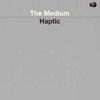 It's dark outside, the windows are open, and the light in the room is slowly bleeding into the shapelessness outside. A trickle of sound pours out of the speakers and evokes a half-frightened reflex; it isn't clear whether something just moved outside the house or if Haptic just added a new element to their droning melancholy. In slow, measured steps, and with liquid ease, The Medium plays out like a subdued, but troubling soundtrack to an unreleased David Lynch film. It's filled with both tense uncertainty and cool atmospheres drowned in low-end heaviness.
It's dark outside, the windows are open, and the light in the room is slowly bleeding into the shapelessness outside. A trickle of sound pours out of the speakers and evokes a half-frightened reflex; it isn't clear whether something just moved outside the house or if Haptic just added a new element to their droning melancholy. In slow, measured steps, and with liquid ease, The Medium plays out like a subdued, but troubling soundtrack to an unreleased David Lynch film. It's filled with both tense uncertainty and cool atmospheres drowned in low-end heaviness.
Haptic's technique is simple and direct. They begin both sides of their debut LP on Flingco Sound with metallic, but somewhat indecipherable drones. After introducing this trembling, often uncertain base, Haptic slowly breathes a plethora of tiny details into their music. The sensation is, at first, a disorienting and troubling one. I mistook several sounds on the record for sounds occurring outside my window. As the sounds intensified, I began to wonder what kind of thing was lurking about just feet away from me. Sizzling fire, dragging feet, muffled voices, bouncing balls, the buzz of electricity, and the whir of motors all find a place for themselves on The Medium. These bits of noise, samples, and odd productions are arranged such that they form convincing and detailed narratives. Within minutes of firing up "One" a complete and almost intrusive scenario had formed in my mind. I could see a weary and worn character shuffling down my street with a drained look upon his face. I could see the cigarette in his hand and I could hear the thoughts crushing his brain into a single-minded state. As he stares off into space and as "One" proceeds to work its magic, all manner of details are added to this picture. The drones turn into buzzing lights and the minutiae produced by the band turn into streams of thoughts and uncollected fragments of ideas. The progression of both songs is like peering into the mind of someone fixated on some premise or memory. The point is that their music is strikingly cinematic and well-sequenced. Their arrangements are obviously thought out and carefully planned or their improv skills are of the highest order. Either way, both sides of this record have an odd and satisfying logic about them.
Most of the sounds employed by the band are organic. Haptic's instruments, whether they be cymbals or boxes filled with junk, are largely naked, so it is easy to believe that what sounds like a piece of burning paper is in fact just a piece of burning paper. I highly doubt this is the case, but such nudity amplifies the band's potency. Not only do they craft shifting and somewhat frightening soundscapes, they produce them with objects that anyone would recognize from their everyday lives. The mix of the familiar and the unfamiliar greatly increases the album's proximity to the listener and the extent to which it can produce emotional responses. The human or emotional component of the record is emphasized by a DVD that is included with the first 100 copies of the record. Amid a progression of shimmering surfaces, video artist Lisa Slodki projects a series of human faces. Her repetitive and hypnotic technique, combined with Haptic's ghostly soundtrack, both emphasizes Haptic's cinematic side and increases the dramatic elements already present in the music. The frozen, sometimes listless faces she focuses upon are frightening in and of themselves. All of them seem lost, alone, or completely without emotion, somehow swallowed by the images projected behind them or by the music that is the occasion of their presence. The only sign of happiness is one that is affected for show. Still, Haptic's music isn't simply doom and gloom. It exudes a kind of ease and directness that makes both songs float by rather quickly. The sounds of a manipulated xylophone and gentle bass pulses push the album along and, at some points, add a jazz-like feeling to the entire affair. The band never breaks character, thoug; their droning simplicity and monolithic approach holds the album together from beginning to end. This simplicity lends the band a cool, almost untouchable aura and ultimately turns all the creeping despair they produce into noir-ish calm.
samples:
Read More
- Administrator
- Albums and Singles
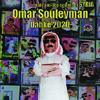 Omar Souleyman's work inhabits the blurry region that separates "embarrassingly misguided and inept pop" from "brilliant outsider art." Despite that, this cadaverously aloof Syrian is the reigning king of his country's cassette kiosks and an extremely popular wedding singer (and rightly so). This is bizarre even by Sublime Frequencies standards.
Omar Souleyman's work inhabits the blurry region that separates "embarrassingly misguided and inept pop" from "brilliant outsider art." Despite that, this cadaverously aloof Syrian is the reigning king of his country's cassette kiosks and an extremely popular wedding singer (and rightly so). This is bizarre even by Sublime Frequencies standards.
Aside from his striking appearance (mustache and omnipresent big '70s sunglasses) and somnambulant demeanor, there is (probably) nothing particularly bizarre about Omar Souleyman. Sure, he's a character, but he is a fairly conventional and soulful vocalist and he specializes in a style of music that is rather mainstream (in Syria, of course). However, he has two secret weapons that elevate him into something wholly outlandish: lyricist Mahmoud Harbi and multi-instrumentalist Rizan Sa'id. Harbi adds an element of surreality to live performances by stoically standing shoulder-to-shoulder with Souleyman, chain-smoking and whispering lyrics into his ear. Sa'id, however, is the one that deserves most of the credit for the strangeness herein: it is his zeal for modern electronics and striking lack of musical restraint that prevents Souleyman from sounding at all like other dabke artists (a traditional style of music that accompanies line-dancing).
"Atabat" opens the album in a surprisingly tame way, as Souleyman passionately bares his poetic soul over a somber drone, punctuated by tasteful bouzok or saz fills. It is quite pleasant, but not especially unique. Notably, Souleyman sounds like he is singing through a thin layer of static or battling a microphone that just can't handle the sheer power of his world-weariness (a production quirk that is maintained for the entire duration of the album). Oddly, this works in his favor, giving his vocals a rawness and immediacy. Then, however, comes the indescribably weird and confusing "Lansob Sherek" (I Will Make A Trap), which roughly resembles an early Cabaret Voltaire trying to drown out a drunken bagpipe ensemble. I don't think my bafflement is a result of any cultural bias or lack of understanding: the distorted percussion fills and unhinged synthesizer shredding would sound clumsy, overenthusiastic, and somewhat demented in any cultural context.
Thankfully, not all of the tracks are in that vein, as Dabke 2020 compiles a variety of tracks from dozens of cassettes recorded over the last decade (as does its recently reissued predecessor Highway to Hassake). For example, "La Sidournak Sayyada" (I'll Prevent The Hunters From Hunting You) is far more accessible, as it marries a big thumping house beat to relatively unmolested traditional melodies and instrumentation. Souleyman then slows things down a bit for the next track (one for the ladies, perhaps?) with the melancholic "Jamila" (Beautiful Woman), but it is sabotaged (or enhanced?) by some over-aggressive percussion and space-y/proggy synth noodling.
"Qalub An Nas" is another frenzied party jam, which I believe is in the Iraqi Choubi style (although Middle Eastern ethnomusicology is not one my strengths). Again, the synths are a bit characteristically crazy and over the top. The same is true for "Laqtuf Ward Min Khaddak", although this track stands out from the others due to Sa'id's more liberal (and possibly arbitrary) use of effects (I definitely hear a phaser, at the very least).
The album closes in rather unexpected fashion with the slow, sensuous groove of "Kaset Hanzal" (Drinking From The Glass of Bitterness). This is probably the best song on the album in the conventional sense, as Sa'id keeps himself relatively reigned in and Souleyman's heartbroken laments are augmented with some beautiful (and untreated) violin and bouzok (or saz).
Usually, world music albums that find their way into the US are either quite serious or influential, so it was jarring to hear something come out of my stereo that initially sounded like shrill and disposable contemporary pop. After several more listens and witnessing some very amusing YouTube clips, however, I was ultimately charmed. I am not sure how much of Souleyman's unique artistic vision is intentional and how much is happy accident, but I am certain there is no other group on earth that sounds like this. Also, Souleyman's inimitable blend of passion, exuberance, and sheer absurdity make for arguably the best party music in the world. It would be nice if someone would invite me to a Syrian wedding, as it seems increasingly unlikely that I will catch any of the remaining Sublime Frequencies European tour dates.
samples:
Read More
- Administrator
- Albums and Singles
 This vinyl-only release from one of Japan's finest psych bands has truly snuck out without fanfare. Currently only available as a very small run LP (although the label appear to be planning to repress it), this is the best releases in Up-Tight's already impressive catalogue. This LP sees them thrust their sound into the abyss and they jump fearlessly in after it.
This vinyl-only release from one of Japan's finest psych bands has truly snuck out without fanfare. Currently only available as a very small run LP (although the label appear to be planning to repress it), this is the best releases in Up-Tight's already impressive catalogue. This LP sees them thrust their sound into the abyss and they jump fearlessly in after it.
It is immediately obvious that Up-Tight have upped their game since their last studio releases. Both Lucrezia and Up-Tight & Makoto Kawabata had that typical PSF Records Japadelica sound, they hit all the right spots and were shit heavy when they needed to be. However, now they seem to be following their ultimate influences, The Velvet Underground, into a wider creative territory. Each of the four pieces that make up The Beginning of the End sound like they could have been from a different but equally great band (exactly what made the Velvets so good).
The first side of the LP opens with “Our Own Portrait” which sees Up-Tight move away from their Les Rallizes Dénudés Junior image and into something even more psychedelic; primal drumming and an insistent bassline allow for Tomoyuki Aoki to unleash some fantastic fuzz guitar. This is followed by “A Song for Your Pain” which is a gentle, sleepy ballad with, of course, more fuzz guitar solos. It is more in line with the quieter parts of previous Up- Tight albums and is the one moment on the LP where they play it safe. Though playing it safe for this band is still something special.
The second side is a different kettle of fish as an oppressive bass buzz and distant cracks of guitar herald in (the aptly titled) “The Destruction.” As the drums join in the din, Up-Tight start to take on the form of early Boris yet create a wall of noise with more power, mass and menace than Boris ever managed to muster. By the end of the piece my turntable has almost rattled itself to pieces; it is one of the most sublime examples of noise freakout to come from Japan (and that in itself is some achievement). The title track rounds off the album, seeing the trio return to a more familiar style. It brings to mind the live jams that appear on the 2007 reissue of the eponymous debut: a languid rhythm and years of reverb drenching the guitar and vocals.
By far this is the best thing Up-Tight have put their name to. It covers all the things that makes Japanese psychedelica interesting to me; the extremes of bludgeoning noise and the delicate beauty without ever becoming something clever for the sake of being clever. The Beginning of the End is worth every mistaken or wayward purchase from the Japanese section of record store, it is superb.
This album is currently vinyl only so unfortunately no sound samples at this point in time, apologies!
Read More
- Administrator
- Albums and Singles
 Another chapter in LTM's Boutique Label reissue campaign of obscure Manchester post-punk label Object Music, this collection presents more than 100 minutes of experiments, improvisations, skewed pop, drone-laden blues, minimal electronic synthpop and weird, dislocated Nurse With Wound-style audio surrealism. A reissue of a double-album originally issued in 1980—a collaborative release by labelmates Steve Solamar (Spherical Objects) and Steve Miro—Sheep From Goats was certainly the most adventurous release by Object Music during its brief existence.
Another chapter in LTM's Boutique Label reissue campaign of obscure Manchester post-punk label Object Music, this collection presents more than 100 minutes of experiments, improvisations, skewed pop, drone-laden blues, minimal electronic synthpop and weird, dislocated Nurse With Wound-style audio surrealism. A reissue of a double-album originally issued in 1980—a collaborative release by labelmates Steve Solamar (Spherical Objects) and Steve Miro—Sheep From Goats was certainly the most adventurous release by Object Music during its brief existence.
Elsewhere in these pages (here and here), I have addressed the bundle of contradictions embodied by Object Music founder and Spherical Objects frontman Steve Solamar, who ceased label operations in 1981 to undergo his own radical operation, resolving his inner contradictions by becoming a woman. At the time of the sessions which eventually became Sheep From Goats, Solamar's contradictions were in full flower. From the name of the project down to the absurdist, eclectic content of the album, paradox seems to have been the key artistic strategy at work here. Steve Miro chose the name The Noise Brothers, but Solamar made a point of changing the spelling of "noise" to "no/yes," in order to carry through the concept of inner contradiction. The album's recording process was somewhat unique as well, with the two Steves meeting for recording sessions over a period of months, a collaboration which produced sides one and four of the double LP. Then, the two each recorded six songs separately, which were distributed over sides two and three. This process results in an album of largely electronic, often improvised music which uses dissonance, incongruity and divergency to its advantage.
The music made by the Steves doesn't much resemble the solo work of Miro or the work of Solamar's Spherical Objects. Although there are a few moments in which he channels the same cryptic blues that he later revisited on the final SO album No Man's Land, most of Solamar's contributions are utterly dislocated and strange, wobbly synthesizer excursions that launch the gray, industrial atmospherics of Thatcherite Manchester into the outer reaches of space. By contrast, Miro recruits his wife Jill/Jae Boyer to sing on three of his tracks, delivering a suite of melancholic, psychedelic pop songs that must have sounded terribly unfashionable at the time of the album's release. Both Brothers' solo contributions are notable in their own way but without question the centerpiece of the album is the sidelong "It Seemed Like A Good Idea At The Time," which in some parallel universe is considered a seminal milestone of electronic music. In our universe, it is rarely considered at all, a 25-minute dirge through a burning brain, all chugging primitive drum machines and art-damaged synth drone, keyboard noodling and mostly wordless vocal improvisations by Solamar. If Steven Stapleton had decided to form a coldwave synthpop band instead of Nurse With Wound, this would have been Side A of the debut album. The closest analog I can think of for this utterly bizarre moment in post-punk history would be John Bender's incredibly obscure Pop Surgery LP, though even this comparison fails to capture the idiosyncrasies at work in The Noyes Brothers.
Boutique's reissue juggles the original tracklisting somewhat, which has the effect of making the album seem even more disorienting, as "It Seemed Like A Good Idea" comes halfway through the listening experience, rather than at the end. This decision was probably made out of pragmatics more than anything else but I appreciate the way in which it augments the album's eclecticism. Listening to Sheep From Goats multiple times, what begins to stand out are not isolated moments or individual tracks, but rather the combined effect of the album's dynamic and scattershot approach. Had the album contained only Solamar's improvised electronic excursions and "Good Idea," it might be easily pidgeonholed as another example (albeit a good one) of early 1980s proto-industrial coldwave, alongside acts like Portion Control, Fad Gadget or Absolute Body Control. However, any album which contains ingenious psych-pop nuggets like Miro's "It Must Be Vibration" alongside Solamar's mind-zapping guitar effects phantasmagoria on "Decision Time" demands to be liberated from the usual genrification schemes applied to musical movements of the past.
Although I do have a certain affection for Miro and Solamar's individual takes on bluesy post-punk, I think Sheep From Goats is at its best when the Steves stop adhering to any kind of song structure. Standout tracks include Solamar's "Pneumonia Bridge," an aquatic sound collage that transforms whalesong into the screams of seagulls, envisaging jaw harp twangs through the disorienting vision doubling of intoxication. One of the best collaborative tracks, "Bo Scat Um I.D." uses the basic building blocks of the new wave—melodic, minor-key basslines, drums, chiming guitars, oppressive synths—but disassembles them, putting them back in an order that no longer makes sense, adding Solamar's incongruous blues harp and throaty, asexual vocal yelps and moans. "Byte To Beat" is a dislocated, claustrophobic samba from another dimension, marrying the UFOs-on-heroin aesthetics of the Liquid Sky soundtrack to the logic of punk in the wake of Throbbing Gristle and Industrial Records.
Boutique's reissue tacks the lengthy collaboration "Good Question" to the end of disc two, a track originally included on the Object Music compilation Do the Maru. It represents the very last recording session by Solamar and Miro, who convene here for a piece which bears some resemblance to "Good Idea," but locates a dark urgency and Krautrock-style propulsion that the shambolic sidelong track on Sheep From Goats never finds. Soon after this collaboration, Solamar quit the music business altogether, and Miro only ever recorded one further album. Boutique's reissue of The Noyes Brothers is an incredible document, an intriguing collection of false starts and loose ends, musical question marks without an answer, experiments which succeed because of their myriad failures. It is complex and evocative soundtrack to the Ballardian, posthuman landscape of early-1980s Manchester, and the mental landscape of artistic methods, creative tensions and gender identities captured in a state of flux.
samples:
Read More
- John Kealy
- Albums and Singles
 Despite having numerous releases on nearly every format imaginable, this is the first 7" from this Ohio threesome. I was afraid that two sides of a 7" would not give them enough time to generate the intoxicating music that I expect from Emeralds but they have conjured up two beautiful miniatures that encapsulate their long-form compositions without sacrificing any quality.
Despite having numerous releases on nearly every format imaginable, this is the first 7" from this Ohio threesome. I was afraid that two sides of a 7" would not give them enough time to generate the intoxicating music that I expect from Emeralds but they have conjured up two beautiful miniatures that encapsulate their long-form compositions without sacrificing any quality.
Side A features a glassy guitar and synth shimmer over a dreamy analogue synth rhythm. As with many of Emeralds’ works, the piece changes ever so slightly over its course (which is definitely on the short side when it comes to this group). Melodies never seem to repeat and even the tempo appears to mutate towards the end. The trio are pushing the sound they explored on last year’s What Happened and they are pushing in the right direction.
Side B is more similar to soundscapes they employed on Solar Bridge and on their many tape releases. Slowly evolving and revolving drones create a deep backdrop for Mark McGuire’s guitar to shine like starlight on a clear night. Unfortunately, the constraints of the format mean that it is all over too soon (even with it being a 33 RPM 7”). However, Fresh Air is yet another exceptional release from Emeralds so even a few minutes of audio bliss is worth the money.
Read More

